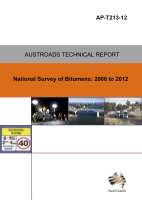Pavement

- Publication no: AP-T213-12
- ISBN: 978-1-921991-51-6
- Published: 23 October 2012
- PDF (free) Download
A database of the properties of bitumens used in Australia has been collated over the course of this project (2006/12). This database will be useful in identifying possible trends in properties associated with changes in the manufacture of Australian bitumens, and the recent increase of bitumen importation into Australia. Fifteen bitumens, submitted from seven Australian jurisdictions, have been tested during the current year of this project. Tests conducted included viscosity measurements at a range of temperatures, durability testing, softening point and penetration determination, chemical characterisation and the calculation of three derived viscosity-temperature parameters. All C170 and C320 bitumen samples that were tested in the current year of this project conformed to the requirements of the Australian bitumen specification. One C170 bitumen sample from Western Australia showed a durability test result that was below the Western Australian 12 month rolling average requirement of 9.5 days minimum. Two bitumen samples which were used as base materials for polymer modified binder (PMB) manufacture were tested in 2011/12. Both samples met the appropriate Northern Territory requirements for viscosity at 60 °C, but one of the samples failed appropriate Northern Territory requirements for durability. Changes in the physical and chemical properties of the bitumen samples tested during the course of this project (2006/12), as well as the relationships between different test parameters, are discussed in this report.
- 1. introduction
- 1.1. Background
- 1.2. Previous Work
- 1.3. Aims
- 2. samples
- 3. test methods
- 3.1. Routine Procedures
- 3.1.1. Rolling Thin Film Oven (RTFO) Treatment
- 3.1.2. Viscosity Testing
- 3.1.3. Durability Testing
- 3.1.4. Softening Point
- 3.1.5. Penetration
- 3.2. Chemical Fractionation Using an Iatroscan
- 4. results
- 4.1. Temperature Susceptibility
- 4.2. Viscosity, Durability and Mass Loss Results
- 4.3. Penetration and Softening Point
- 4.4. Iatroscan Fractions
- 5. discussion
- 5.1. Compliance with Specifications
- 5.2. Temperature Susceptibility
- 5.3. Penetration Index
- 5.4. Softening Point
- 5.5. Durability
- 5.6. Iatroscan Fractions
- 5.7. Gaestel Index
- 6. investigation of possible correlations between test parameters
- 7. conclusions
- References
- Standards Australia
